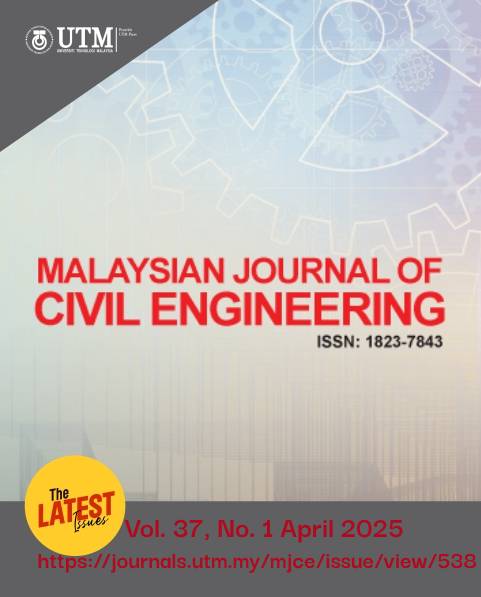STRESS DISTRIBUTION ANALYSIS ON THE SPILLWAY STRUCTURE
DOI:
https://doi.org/10.11113/mjce.v37.23149Keywords:
Spillway, SAP2000, Stress Distribution Graph, Acting LoadsAbstract
The stress distribution varies between different areas. This is caused by several main factors such as spillway height and the magnitude of the forces. The research objective is to analyze stress distribution on the spillway structure due to the acting forces and to generate graphs that can be used as a quick way to obtain its structural stress values. The method employs 12 models of ogee-crested spillways with varying heights. The loads acting include hydrostatic pressure, mud, uplift, and self-weight. Stress distribution is calculated using SAP2000 software. The stress results are illustrated against spillway height. Trendlines and polynomial equations are fitted to the graphs and tested with interpolation and extrapolation. Graph validation is performed against previous studies, showing reasonably good accuracy. In conclusion, stress distribution on the spillway structure due to hydrostatic pressure, mud, uplift, and self-weight varies in each area. This study successfully obtains graphs that can be used as a quick method to obtain its structural stress values.
References
Karamma, R. & Sukri, A.S. 2019. Pemodelan Stabilitas Bendung Maros dengan Menggunakan Aplikasi SAP2000. SemanTIK. 5(1): 53–60. DOI: https://doi.org/10.5281/zenodo.2652067
Burritt, R. L., & Christ, K. L. 2018. Water risk in mining: Analysis of the Samarco dam failure. Journal of cleaner production. 178(2018): 196-205. DOI: https://doi.org/10.1016/j.jclepro.2018.01.042
Chanson, H. 2022. Energy dissipation on stepped spillways and hydraulic challenges-Prototype and laboratory experiences. Journal of Hydrodynamics. 34(1): 52-62. DOI: https://doi.org/10.1007/s42241-022-0005-8
Jalili Kashtiban, Y., Saeidi, A., Farinas, M. I., & Quirion, M. 2021. A review on existing methods to assess hydraulic erodibility downstream of dam spillways. Water. 13(22): 3205-3216.
DOI: https://doi.org/10.3390/w13223205.
Liu, Z., Jia, J., Feng, W., Ma, F., & Zheng, C. 2017. Shear strength of cemented sand gravel and rock materials. Sains Malaysiana, 46(11), 2101-2108. DOI: http://dx.doi.org/10.17576/jsm-2017-4611-10.
Kocaer, Ö., & Yarar, A. 2020. Experimental and numerical investigation of flow over ogee spillway. Water Resources Management. 34(13): 3949-3965. DOI: https://doi.org/10.1007/s11269-020-02558-9
Loron, R. S., Samadi, M., & Shamsai, A. 2023. Predictive explicit expressions from data-driven models for estimation of scour depth below ski-jump bucket spillways. Water Science & Technology. 23(1): 304-316. DOI: https://doi.org/10.2166/ws.2022.421
Zacchei, E., & Molina, J. L. 2020. Reviewing arch-dams’ building risk reduction through a sustainability–safety management approach. Sustainability. 12(1): 1-21. DOI: https://doi.org/10.3390/su12010392
Al Mamun, A., Sohel, M., Mohammad, N., Sunny, M. S. H., Dipta, D. R., & Hossain, E. 2020. A comprehensive review of the load forecasting techniques using single and hybrid predictive models. IEEE Access. 8(1): 134911-134939. DOI: https://doi.org/10.1109/ACCESS.2020.3010702
Haghbin, M., & Sharafati, A. 2022. A review of studies on estabistimating the discharge coefficient of flow control structures based on the soft computing models. Flow Measurement and Instrumentation. 23(1): 102-119. DOI: https://doi.org/10.1016/j.flowmeasinst.2021.102119
Othman, L. S., & Abdulrahman, K. Z. 2023. Advancements in Flow Behavior Investigation and Performance Enhancement of Morning Glory Spillways: A Systematic Review of Numerical and Physical Models. Iranian Journal of Science and Technology, Transactions of Civil Engineering. 11(1): 1-35. DOI: https://doi.org/10.1007/s40996-023-01249-w
Maurizi, M., Gao, C., & Berto, F. 2022. Predicting stress, strain and deformation fields in materials and structures with graph neural networks. Scientific Reports. 12(1): 1-12. DOI: https://doi.org/10.1038/s41598-022-26424-3
Abela, C. M. 2020. Anchor Gallery Designs for Tainter Gate Active Anchorage Systems. Practice Periodical on Structural Design and Construction. 25(2): 1-17. DOI: https://doi.org/10.1061/(ASCE)SC.1943-5576.0000470
Fadhli Bargess, M., Lesmana, C. & Yussac Tallar, R. 2009. Analisis Struktur Bendung dengan Metode Elemen Hingga. Jurnal Teknik Sipil. 5(1): 1–21. DOI: https://doi.org/10.28932/jts.v5i1.1309
Oktaviani, M., Sari, D. Y., Fernanda, Y., & Arafat, A. 2023. Method of Calculating the Forces on the 2D/3D Truss: A Review. MOTIVECTION: Journal of Mechanical, Electrical and Industrial Engineering. 5(3): 433-446. DOI: https://doi.org/10.46574/motivection.v5i3.226
Maranzoni, A., & Tomirotti, M. 2023. Three-dimensional numerical modelling of real-field dam-break flows: review and recent advances. Water. 15(17): 3130-3139. DOI: https://doi.org/10.3390/w15173130
Falkner, F. H. 1936. Hydraulic-Laboratory Projects of the Corps of Engineers, US Army. Transactions of the American Society of Mechanical Engineers. 58(7): 561-575. DOI: https://doi.org/10.1115/1.4020361
Chow, V. T. 1959. Open-channel hydraulics. New York: McGraw-Hill.
Darmawan, M. F., Setiawan, A. F., Satyarno, I., & Awaludin, A. (2024). Nonlinear Simulations To Evaluate The Code-Based Response Modification Factor For Seismic Design Of Slab-On-Pile Structure. ASEAN Engineering Journal. 14(1): 101-111. DOI: https://doi.org/10.11113/aej.v14.20155
Ferdowsi, A., Mousavi, S. F., Farzin, S., & Karami, H. 2020. Optimization of dam's spillway design under climate change conditions. Journal of Hydroinformatics. 22(4): 916-936. DOI: https://doi.org/10.2166/hydro.2020.019
Wahl, T. L., Frizell, K. W., & Falvey, H. T. 2019. Uplift pressures below spillway chute slabs at unvented open offset joints. Journal of Hydraulic Engineering. 145(11): 1-11. DOI: https://doi.org/10.1061/(ASCE)HY.1943-7900.0001637
Suifa, Z., Ahmada, N., Othmana, M., Jelania, J., & Yoshimurab, C. 2022. A Distributed Model of Hydrological and Sediment Transport in The UPNM Catchment. Jurnal Teknologi. 84(2): 163-170. DOI: https://doi.org/10.11113/jurnalteknologi.v84.17482
Badan Standardisasi Nasional. 2020. SNI - 1727 - 2020 Beban Desain Minimum dan Kriteria terkait untuk Bangunan Gedung dan Struktur Lain. Jakarta: Badan Standardisasi Nasional.
















